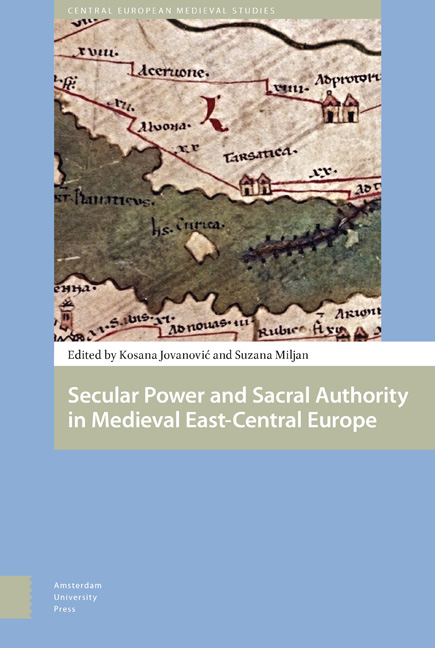Book contents
- Frontmatter
- Contents
- List of Figures and Tables
- Acknowledgements
- Foreword
- Folklore of the Medieval Kings of Hungary: Preliminary Research Report
- Variations on Nobility in Central and South-Eastern Europe: An Introduction
- The Changes of Office of Ban of Slavonia after the Mongol Invasion in Hungary (1242-1267)
- The Reconstruction and Role of Roads in the Formation of a Medieval Cultural Landscape: The Example of Episcopal Estates of Dubrava, Ivanić and Čazma
- From Castle-Warrior to Nobleman: Case Study of a Family of Slavonian Lesser Nobility
- Late Medieval Village in Turopolje (Slavonia): The Example of Donja Lomnica
- Economic Development and Transformation of the Pauline Monasteries near Senj under the Frankapan Patronage
- The Society of the Noble Judges in Northeastern Hungary during the Reign of King Sigismund (1387-1437)
- Development of Ragusan Diplomatic Service in the First Half of the Fifteenth Century: Father and Son at the Court of Duke Sandalj Hranić
- Croatian Students at the University of Prague in the Fifteenth Century
- A Contribution to Medieval Croatian Diplomatics: Cyrillic Charters of Croatian Nobility from the Franciscan Monastery on Trsat in Rijeka
- Peter of Crkvica, a Man Who Could Be Trusted: The Career of a Middle-Ranking Cleric and Diplomat in the Kingdom of Hungary in Mid-Fifteenth Century
- The Nobility of the Despotate of Serbia between Ottoman Empire and Hungary (1457-1459)
- List of Contributors
- Index
The Reconstruction and Role of Roads in the Formation of a Medieval Cultural Landscape: The Example of Episcopal Estates of Dubrava, Ivanić and Čazma
Published online by Cambridge University Press: 12 December 2020
- Frontmatter
- Contents
- List of Figures and Tables
- Acknowledgements
- Foreword
- Folklore of the Medieval Kings of Hungary: Preliminary Research Report
- Variations on Nobility in Central and South-Eastern Europe: An Introduction
- The Changes of Office of Ban of Slavonia after the Mongol Invasion in Hungary (1242-1267)
- The Reconstruction and Role of Roads in the Formation of a Medieval Cultural Landscape: The Example of Episcopal Estates of Dubrava, Ivanić and Čazma
- From Castle-Warrior to Nobleman: Case Study of a Family of Slavonian Lesser Nobility
- Late Medieval Village in Turopolje (Slavonia): The Example of Donja Lomnica
- Economic Development and Transformation of the Pauline Monasteries near Senj under the Frankapan Patronage
- The Society of the Noble Judges in Northeastern Hungary during the Reign of King Sigismund (1387-1437)
- Development of Ragusan Diplomatic Service in the First Half of the Fifteenth Century: Father and Son at the Court of Duke Sandalj Hranić
- Croatian Students at the University of Prague in the Fifteenth Century
- A Contribution to Medieval Croatian Diplomatics: Cyrillic Charters of Croatian Nobility from the Franciscan Monastery on Trsat in Rijeka
- Peter of Crkvica, a Man Who Could Be Trusted: The Career of a Middle-Ranking Cleric and Diplomat in the Kingdom of Hungary in Mid-Fifteenth Century
- The Nobility of the Despotate of Serbia between Ottoman Empire and Hungary (1457-1459)
- List of Contributors
- Index
Summary
In one of the first stages of my research, which dealt with segments of the cultural landscape of the three estates of the Bishopric of Zagreb (Dubrava, Ivanić and Čazma) from the late eleventh to mid-fourteenth century, it became clear that roads played a massive role in formation of the landscape. Therefore, this article attempts to reconstruct the routes of medieval roads and trails that passed through this geographical area situated about 50 kilometres to the east of Zagreb. The assumption was that the identification of a network of regional and local transport routes, in ancient times and during the medieval period, is very important for determining the position of settlements and fortifications, and the logic of their positions. With the information that could be drawn from the scholarship, historical sources and archaeological materials, at least answers to an important question about the continuity or discontinuity of certain points of settlement could be suggested. A reconstruction of the ancient and medieval roads and paths was done in order to be able to define the potential impact of the ancient routes on the formation of medieval settlements, but also on the way the medieval roads and paths had impacted on their further development. At the same time, it was possible to survey the relationship between ancient and medieval traffic routes in the area of the research.
Although papers on the subject of ancient and medieval road routes of the wider geographical area exist, they only partially cover the space that has been the focus of this research. In this article, as the basis for further research, I present only the basic information with the most important conclusions and a map, all of them based on published historical sources, and the archaeological sites and finds (from Antiquity and the Middle Ages) in the area of the three episcopal estates stated previously.
The episcopal estate of Dubrava is mentioned for the first time in the charter of Archbishop Felician of Esztergom (1134) which is also the first written document of medieval Slavonia. Although Čazma and Ivanić, as well as two other estates, are not explicitly mentioned in the charter, according to the one issued in 1163, which defines the south-east border of the estate of Dubrava, it is almost the same as the south-east border of the later formed Episcopal estate of Čazma (mentioned for the first time, with its borders, in 1200).
- Type
- Chapter
- Information
- Publisher: Amsterdam University PressPrint publication year: 2018



